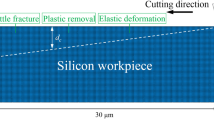Abstract
A theoretical analysis for the mechanism of ductile chip formation in the cutting of brittle materials is presented in this paper. The coexisting crack propagation and dislocation in the chip formation zone in the cutting of ductile materials are examined based on an analysis of the geometry and forces in the cutting region, both on Taylor’s dislocation hardening theory and the strain gradient plasticity theory. It was found that the ductile chip formation was a result of large compressive stress and shear stress in the chip formation zone, which shields the growth of pre-existing flaws by suppressing the stress intensity factor K I . Additionally, ductile chip formation in the cutting of brittle materials can result from the enhancement of material yield strength in the chip formation zone. The large compressive stress can be generated in the chip formation zone with two conditions. The first condition is associated with a small, undeformed chip thickness, while the second is related to the undeformed chip thickness being smaller than the radius of the tool cutting edge. The analysis also shows that the thrust force F t is much larger than the cutting force F c . This indicates that large compressive stress is generated in the chip formation zone. This also confirms that the ductile chip formation is a result of large compressive stress in the chip formation zone, which shields the growth of pre-existing flaws in the material by suppressing the stress intensity factor K I . The enhancement of material yield strength can be provided by dislocation hardening and strain gradient at the mesoscale, such that the workpiece material can undertake the large cutting stresses in the chip formation zone without fracture. Experiments for ductile cutting of tungsten carbide are conducted. The results show that ductile chip formation can be achieved as the undeformed chip thickness is small enough, as well as the undeformed chip thickness is smaller than the tool cutting edge radius.
Similar content being viewed by others
References
Ngoi BKA, Sreejith PS (2000) Ductile regime finish machining–a review. Int J Adv Manuf Technol 16:547–550
Blackley WS, Scattergood RO(1994) Chip topography for ductile-regime machining of germanium. ASME Trans, J Eng Ind 116:263–266
Blake P, Bifano TG, Dow T, Scattergood RO (1988) Precision machining of ceramic materials. Am Ceram Soc Bull 67:1038–1044
Bifano TG, TA Dow, RO Scattergood (1991) Ductile-regime grinding: a new technology for machining brittle materials. ASME Trans, J Eng Ind 113:184–189
Hahn GT, Reid CN, Gilbert A (1963) The dislocation dynamics of plastic flow. Proceedings of International Production Engineering Research Conference, Pittsburgh, USA, pp 293–301
Rice JR, Thomsom R (1974) Ductile versus brittle behavior of crystals. Philos Mag 29:73–97
Michot G, de Oliveira MAL, Champier G (1999) A model of dislocation multiplication at a crack tip influencing on the brittle to ductile transition. Mater Sci Eng A272:83–89
Hartmaier A, Gumbsch P (1999) The brittle-to-ductile transition and dislocation activity at crack tips. J Comput-Aided Mater Des 6:145–155
Thomsom RM, Sinclair JE (1982) Mechanics of cracks screened by dislocation. Acta Metall 30:1325–1334
Ohr SM (1985) An electron microscope study of crack tip deformation and its impact on the dislocation theory of fracture. Mater Sci Eng 72:1–35
Ferney BD, Hsia KJ (1999) The influence of multiple slip systems on the brittle-ductile transition in silicon. Mater Sci Eng A272:422–430
Samuels J, Roberts SG, Hirsch PB (1988) The brittle-to-ductile transition in silicon. Mater Sci Eng A105/106:39–46
Ebrahimi F, Shrivastava S (1997) Crack initiation and propagation in brittle-to-ductile transition regime of NiAl single crystals. Mater Sci Eng A239-A240:386–392
Imayev VM, Imayev RM, Salishchev GA (2000) On two stages of brittle-to-ductile transition in TiAl intermetallic. Intermetallics 8:1–6
Chen W, Ravichandran G (2000) Failure mode transition in ceramics under dynamic multiaxial compression. Int J Fract 101:141–159
Yan J, Yoshino M, Kuriagawa T, Shirakashi T, Syoji K, Komanduri R (2001) On the ductile machining of silicon for micro electro-mechanical system (MEMS), opto-electronic and optical applications. Mater Sci Eng, A Struct Mater: Prop Microstruct Process 297:230–234
Moriwaki T, Shamoto E, Inoue K (1992) Ultraprecision ductile cutting of glass by applying ultrasonic vibration. Ann CIRP 41:141–144
Liu K, Li XP (2001) Ductile cutting of tungsten carbide. J Mater Process Technol 113:348–354
Liu K, Li XP (2001) Modeling of ductile cutting of tungsten carbide. Trans NAMRI/SME XXIX:251–258
Irwin GR (1957) Analysis of stress and strain near the end of a crack traversing a plate. Trans ASME, J Appl Mech 24:361–364
Broek D (1984) Elementary engineering fracture mechanics. Martinus Nijihoff Publishers, The Hague, pp 33–122
Cottrell AH (1953) Dislocations and plastic flow in crystals. The Clarendon Press, Oxford, pp 151–176
Kovacs I, Zsoldos L (1973) Dislocations and plastic deformation. Pergamon Press, Oxford, pp 252–283
Fleck NA, Hutchinson JW (1997) Strain gradient plasticity. In: Hutchinson JW, Wu TY (eds) Advances in applied mechanics, vol 33. Academic Press, New York, pp 295–361
Gao H, Huang Y, Nix WD, Hutchinson JW (1999) Mechanism-based strain gradient plasticity-I. Theory. J Mech Phys Solids 47:1239–1263
Huang Y, Gao H, Nix WD, Hutchinson JW (2000) Mechanism-based strain gradient plasticity-II. Anal J Mech Phys Solids 48:99–128
Bifano T, Bierden PA (1997) Fixed-abrasive grinding of brittle hard disk substrates. Int J Mach Tools Manuf 37:935–946
Author information
Authors and Affiliations
Corresponding author
Rights and permissions
About this article
Cite this article
Liu, K., Li, X.P. & Liang, S.Y. The mechanism of ductile chip formation in cutting of brittle materials. Int J Adv Manuf Technol 33, 875–884 (2007). https://doi.org/10.1007/s00170-006-0531-5
Received:
Accepted:
Published:
Issue Date:
DOI: https://doi.org/10.1007/s00170-006-0531-5



